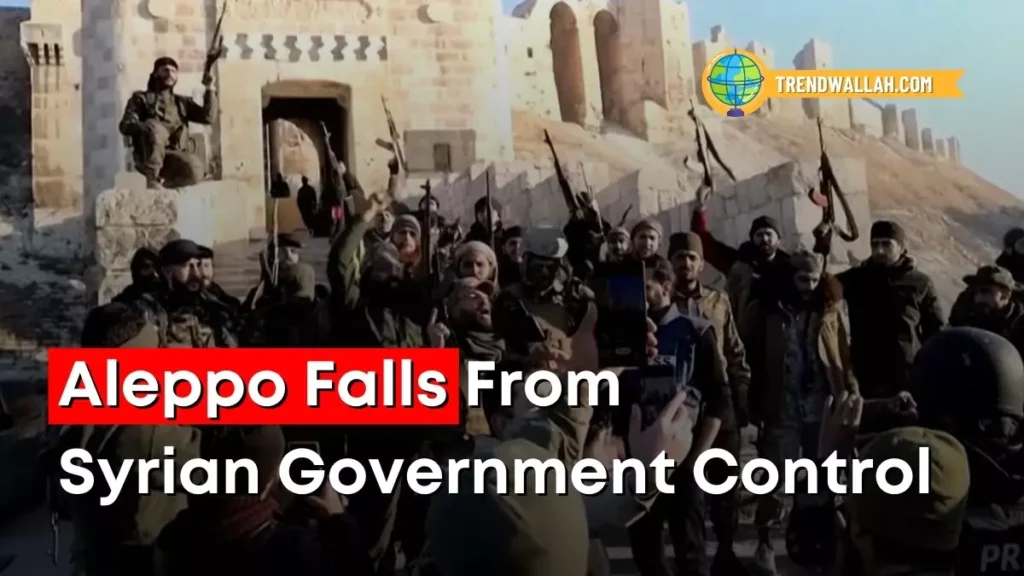
Aleppo Falls From Syrian Government Control– The second-largest city in Syria, Aleppo, has fallen out of Syrian government control for the first time in over a decade. This significant event occurred following a sudden offensive by Islamist-dominated rebel factions, marking a pivotal moment in the ongoing Syrian conflict.
Aleppo Falls: A Turning Point in the Syrian War
Aleppo, a historic city known for its cultural and economic importance, is now under the control of rebel forces for the first time since the start of the civil war in 2011. This development is a major setback for the Syrian government, which had reclaimed the city in 2016 after intense fighting.
Rebel Offensive Led by Hayat Tahrir al-Sham (HTS)
The rebel advance was spearheaded by Hayat Tahrir al-Sham (HTS), a faction with ties to Al-Qaeda, along with allied rebel groups. These factions launched a coordinated attack, seizing control of Aleppo’s airport and surrounding towns.
Kurdish-Controlled Areas in Aleppo
Despite the rebel victory, parts of northern Aleppo remain under Kurdish control. These areas are administered by the Syrian Democratic Forces (SDF), a US-backed militia primarily composed of the People’s Protection Units (YPG).
Key Players in Aleppo Falls From Syrian Government Control
| Group/Faction | Control | Support/Backing |
| Hayat Tahrir al-Sham (HTS) | Majority of Aleppo city | None (Independent rebel faction) |
| Syrian Democratic Forces (SDF) | Northern districts of Aleppo | United States |
| Syrian Government Forces | None in Aleppo city post-offensive | Russia, Iran, Hezbollah |
Role of International Powers
Russia and Iran, key allies of the Syrian government, have expressed concern over the loss of Aleppo. Russian airstrikes have been launched in response, marking their first strikes on Aleppo since 2016. However, these efforts have been criticized for their limited impact due to reduced Russian military presence in Syria.
Casualties and Humanitarian Crisis
Over 370 people have been killed in the fighting, including at least 48 civilians. Russian airstrikes and urban combat have worsened the humanitarian crisis, leading to significant civilian displacement and casualties.
Implications of Aleppo’s Fall
Weakening of Syrian Government Forces The ease with which rebels captured Aleppo highlights the weakened state of the Syrian military despite support from Russia and Iran.
Broader Regional Impacts- The fall of Aleppo has implications for regional power dynamics, particularly with the weakening influence of Iran in the Middle East.
Ongoing Humanitarian Crisis- The conflict has intensified the humanitarian challenges in Syria, with growing civilian casualties and displacement.
Also Read
| Sarkari Exam News – Latest Update on Competitive Exams | Free Previous Year Question Papers | Static GK For Competitive Exams |
FAQs on Aleppo Falls From Syrian Government Control
Aleppo fell due to a surprise offensive by Hayat Tahrir al-Sham (HTS) and allied rebel factions, who capitalized on the Syrian government’s weakened defenses.
HTS led the offensive, capturing Aleppo’s airport and several towns, marking a significant rebel victory.
The SDF continues to maintain control over northern districts of Aleppo and remains a key player in the region’s stability.
The loss highlights the Syrian government’s vulnerability and the declining effectiveness of its forces despite backing from Russia and Iran.
The situation is dire, with over 370 fatalities and widespread displacement. Russian airstrikes have exacerbated civilian casualties.
Russia launched airstrikes on rebel-held areas in Aleppo and has pledged continued support for the Syrian government.
Aleppo’s loss has reshaped the Syrian conflict, weakening the government and altering regional power dynamics.
